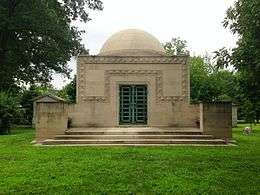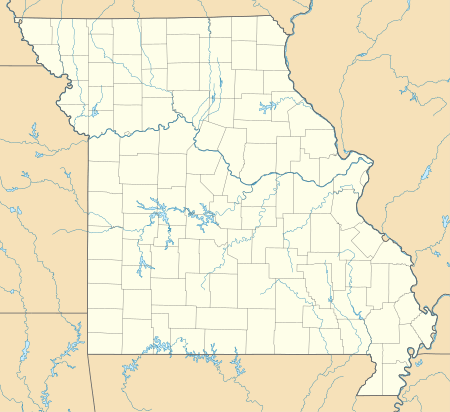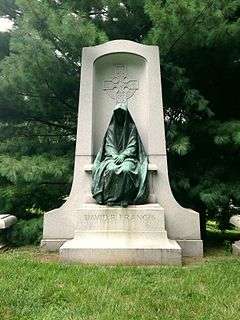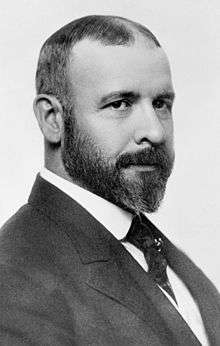Bellefontaine Cemetery
Bellefontaine Cemetery is a nonprofit, non-denominational cemetery and arboretum located in St. Louis, Missouri. Founded in 1849 as a rural cemetery, Bellefontaine is home to a number of architecturally significant monuments and mausoleums such as the Louis Sullivan-designed Wainwright Tomb, which is listed on the National Register of Historic Places. The cemetery contains 314 acres (1.27 km2) of land and over 87,000 graves, including those of William Clark, Adolphus Busch, Thomas Hart Benton, and William S. Burroughs. Many Union and Confederate soldiers from the American Civil War are buried at Bellefontaine, as well as numerous local and state politicians.
 The Wainwright Tomb at Bellefontaine Cemetery is listed on the National Register of Historic Places. | |
 Location of Bellefontaine Cemetery | |
| Details | |
|---|---|
| Established | 1849 |
| Location | 4947 West Florissant Avenue St. Louis, Missouri |
| Country | United States |
| Coordinates | 38.69095°N 90.23494°W |
| Type | Public |
| Size | 314 acres (127 ha) |
| No. of graves | 87,000 |
| Website | bellefontainecemetery |
| Find a Grave | Bellefontaine Cemetery |
History
On March 7, 1849, banker William McPherson and lawyer John Fletcher Darby assembled a group of some of St. Louis's most prominent citizens to found the Rural Cemetery Association of St. Louis. This association sought to respond to the needs of a rapidly growing St. Louis by establishing a new cemetery several miles outside city limits. St. Louis was experiencing exponential population growth during this time and city leaders thought that the existing graveyards, which were mostly concentrated along Jefferson Avenue near the city center, were an impediment to urban development. Many were also convinced that city cemeteries represented a public health hazard (see miasma theory). These problems were compounded during the summer of 1849, when a massive cholera epidemic swept through St. Louis and claimed the lives of more than 4,000 people. With existing cemeteries running out of space to expand, and with many residents fearing that fumes from nearby cemeteries could cause them to fall ill en masse once again, this epidemic further underscored the need for a new rural cemetery for St. Louis.[1]
In 1849, the Rural Cemetery Association purchased the former Hempstead family farm located five miles northwest of the city, with the intent to turn it into a large rural cemetery modeled after Père Lachaise Cemetery in Paris and Mount Auburn Cemetery in Massachusetts. The 138-acre Hempstead farm was situated along the road to Fort Bellefontaine, and as a result the Association decided to name its new cemetery after the fort. Within a few months, the Association had hired landscape architect Almerin Hotchkiss, who helped design Green-Wood Cemetery in Brooklyn, New York, to begin drafting and implementing a master plan for Bellefontaine. Hotchkiss went on to serve as superintendent of the cemetery for the next 46 years; he designed most of Bellefontaine's roadways and landscaping, and oversaw maintenance of the grounds. During this time, the cemetery steadily acquired more land so as to provide room for future growth. By 1865, it had reached its present-day size of 314 acres.[2]
The first burial at Bellefontaine Cemetery took place on April 27, 1850, and the official dedication followed several weeks later. Bodies from older graveyards within the city of St. Louis were moved to Bellefontaine, including some from the cemetery by the Old Cathedral near the Mississippi River. Bellefontaine was also the resting place for several victims of the 1855 Gasconade Bridge train disaster, the worst railroad disaster in Missouri history. Also interred at Bellefontaine are members of several notable brewing families, including the Anheusers, Buschs, Lemps, and Griesediecks.
In 1909, the renowned St. Louis architectural firm Eames and Young was commissioned to design a new chapel for the cemetery. The Hotchkiss Chapel, named for the cemetery's first architect, was completely renovated in 2009, and an indoor columbarium was added on to the back. The chapel is currently used for weddings and memorial services. Two new outdoor columbaria have also opened for inurnments; and a "green burial" natural interment section is pending. Cemetery patrons with traditional tastes for family lot group burials and private mausoleums can still obtain these memorialization options at this historic cemetery, which has the largest collection of private (family) mausoleums and sarcophagi in the State of Missouri, in a wide array of architecturally-acclaimed historical styles. Space for traditional casketed/vaulted ground burial exists within Bellefontaine's dedicated grounds for the next 200 years at present rates of usage.
Cemetery today
As of 2012 over 87,000 people have been buried at Bellefontaine Cemetery, and approximately 100 new burials take place each year. Bellefontaine remains a non-profit, non-denominational cemetery, and still holds over 100 acres of open, unused land. Some of this extra land has recently been converted into prairie and woodland. Bellefontaine contains over 14 miles of paved roads and, as an accredited arboretum, is home to over 180 species of trees and shrubs. A new lakeside garden and columbarium were completed in 2010, and other major landscaping projects are planned or in progress.
The cemetery contains the graves of many prominent pioneers to the West, as well as businessmen, politicians, and generals who remain significant figures in the history of St. Louis and the United States. The oldest graves in the cemetery are located on pioneer Edward Hempstead’s family lot and date as far back as 1816. Many of the wealthiest families at Bellefontaine are interred in ornate mausoleums which overlook the Mississippi River and draw from Classical, Romanesque, Gothic, and Egyptian architectural styles. Among the most notable mausoleums in the cemetery are: the Wainwright Tomb, designed for Charlotte Dickson Wainwright by the famed Chicago school architect Louis Sullivan in 1892; the Busch Mausoleum, designed for Adolphus Busch and Lilly Anheuser by Barnett, Haynes & Barnett in 1915; and the Brown Brothers Mausoleums, designed in 1910 by Isaac Taylor and in 1928 by Mauran, Russell and Crowell. There are also a number of large family plots in the cemetery, many of which are marked by tall obelisk monuments with elaborate bases. Guided tours of the cemetery’s main historical and architectural highlights are available and are open to the public. Alternatively, visitors can obtain self-guided tour brochures at the cemetery office.[3]
The cemetery was listed on the National Register of Historic Places in 2014.[4]
Notable burials

- Chris von der Ahe (1851–1913), entrepreneur and owner of the St. Louis Brown Stockings, which later became the St. Louis Cardinals
- Eberhard Anheuser (1805–1880), father-in-law of Adolphus Busch; president and CEO of Eberhard Anheuser and Company (predecessor of Anheuser-Busch)
- George I. Barnett (1815–1898), prominent St. Louis architect
- Edward Bates (1793–1869), United States Attorney General under President Abraham Lincoln
- William Beaumont (1785–1853), U.S. Army surgeon, known as the "Father of Gastric Physiology" due to his research on human digestion
- Robert Benecke (1835–1903), early St. Louis photographer
- Thomas Hart Benton (1782–1858), prominent U.S. Senator (1821–1851) who championed western expansion and the Homestead Act
- Thekla M. Bernays (1856–1931), Women's suffrage's activist, author and lecturer.
- Daniel Bissell (1768–1833) U.S. Army officer in War of 1812 and on the American Frontier
- Horace Bixby (1826–1912), steamboat pilot and captain whose "cub pilot" was Mark Twain
- Francis Preston Blair, Jr. (1821–1875), Union Army general in the Civil War, politician
- Susan Blow (1843–1916), educator, known as the "Mother of Kindergarten"
- Benjamin Bonneville (1796–1876), French-born officer in the U.S. Army, fur trapper, and explorer in the American West
- Robert S. Brookings (1850–1932), businessman and philanthropist, founder of the Brookings Institution, donor to Washington University in St. Louis
- Don Carlos Buell (1818–1898), U.S. Army general; led Union armies in the battles of Shiloh and Perryville
- William Seward Burroughs (1857–1898), inventor of the mechanical calculator and founder of Burroughs Corporation
- William S. Burroughs (1914–1997), author of novel Naked Lunch, icon of Beat Generation
- Adolphus Busch (1838–1913), founder of Anheuser Busch Company[5]
- wife Lilly Eberhard Anheuser (d. 1928)
- Isidor Bush (1822–1898), intellectual, publisher, viticulturalist
- James Gay Butler (1840–1916), tobacco manufacturer, major supporter of Lindenwood University
- Given Campbell (1835–1906), Confederate officer who led the final escape of Jefferson Davis in the last days of the Civil War
- Robert Campbell (1804–1879), frontiersman, banker, real estate mogul, steamboat owner
- Virginia Kyle Campbell (1822–1882), socialite, wife of Robert Campbell
- William Chauvenet (1820–1870), scholar, educator
- William Clark (1770–1838), explorer of Louisiana Purchase territory
- Norman Jay Coleman (1827–1911), first United States Secretary of Agriculture
- Alban Jasper Conant (1821–1915), artist, author, educator; best known for his "Smiling Lincoln" portraits
- Phoebe Wilson Couzins (1842–1913), pioneer suffragette, one of the first female lawyers in the United States
- Ned Cuthbert (1845–1905), baseball player
- Forrest C. Donnell (1884–1980), U.S. Senator, 40th Governor of the State of Missouri[6]
- James Eads (1820–1887), engineer who constructed bridges, railroads, and ironclad warships
- Albert Gallatin Edwards (1812–1892), Assistant Secretary of the U.S. Treasury under President of the United States Abraham Lincoln and founder of brokerage firm A. G. Edwards
- William Greenleaf Eliot (1811–1887), Unitarian minister and civic leader
- George Engelmann (1809–1884), botanist
- Sarkis Erganian (1870–1950), Ottoman Armenian painter
- Bernard G. Farrar Jr. (1831–1916), Union Army colonel in the Civil War
- Thomas Clement Fletcher (1827–1899), 18th Governor of the State of Missouri, issued the proclamation abolishing slavery in the state
- Della May Fox (1870–1913), actress, singer
- David R. Francis (1850–1927), statesman, United States Secretary of the Interior, governor of Missouri, mayor of St. Louis, ambassador to Russia, president of the 1904 St. Louis World's Fair
- Hamilton Rowan Gamble (1798–1864), 16th Governor of the State of Missouri during the Civil War, chief justice of the Missouri Supreme Court at the time of the Dred Scott Decision in 1852
- Frederick D. Gardner (1869–1933), 34th Governor of the State of Missouri and St. Louis funeral director and coffin manufacturer
- Edward James Gay (1816–1889), U.S. Representative of Louisiana
- Jessie Gaynor (1863–1921), composer of children's music
- Fitz W. Guerin (1846–1903), Medal of Honor recipient in the American Civil War
- Rebecca N. Hazard (1826–1912), first president of the American Woman's Suffrage Association (1826) to reside west of the Mississippi River
- Edward Hempstead (1780–1817), lawyer, pioneer, delegate to the U.S. House of Representatives for Missouri Territory (1812–1814)
- James Eads How (1874–1930), son of wealthy St. Louis family, known as the "Millionaire Hobo"
- Benjamin Howard (1760–1814), first governor of Missouri Territory, brigadier general in the War of 1812
- Bill Joyce (baseball) (1865–1941), professional baseball player and manager
- Stephen W. Kearny (1794–1848), officer in the U.S. Army; played a significant role in the Mexican–American War and the conquest of California
- George Kessler (1862–1923), landscape architect and city planner
- Albert Bond Lambert (1875–1946), businessman, aviator, Olympic athlete; namesake of Lambert–St. Louis International Airport
- Frederick William Lehmann (1853–1931), prominent lawyer, statesman, United States Solicitor General, rare book collector
- Theodore Link (1850–1923), architect of St. Louis Union Station
- Manuel Lisa (1772–1820), fur trader and explorer
- Richard Barnes Mason (1797–1850), U.S. Army officer, fifth military governor of California before it became a U.S. state
- William Massie (1829–1910), riverboat captain famous for living with the bullet that killed Wild Bill Hickock lodged in his wrist.[7][8]
- James Smith McDonnell (1899–1980), founder of McDonnell Aircraft Corporation
- John McNeil (1813–1891), Union Army general in the Civil War
- James F. Merton (1845–1900), Medal of Honor recipient for actions during the 1871 United States expedition to Korea.
- John Miller (1781-1846), Fourth Governor of the State of Missouri
- Virginia Minor (1824–1894), women's suffrage activist[9]
- Charles Nagel (1849–1940), U.S. Representative, last United States Secretary of Commerce and Labor, co-founder of the United States Chamber of Commerce
- John O'Fallon (1791–1865), railroad executive, philanthropist, namesake of O'Fallon, Missouri and O'Fallon, Illinois, nephew of William Clark
- John Mason Peck (1789–1858), Baptist missionary, educator and journalist
- Hannah D. Pittman (1840–1919), author of the first American comic opera.
- Truston Polk (1811–1876), U.S. Senator (1857–1862) & 12th Governor of the State of Missouri
- John Pope (1822–1892), Union Army general in the Civil War, known for his defeat at the Second Battle of Bull Run
- Sterling Price (1809–1867), Confederate Army major general during the Civil War, U.S. Army brigadier general during the Mexican–American War, 11th Governor of the State of Missouri
- James McIlvaine Riley (1849–1911), Co-founder of Sigma Nu International Fraternity
- Parrish Sisters, Williamina (1879–1941) and Grace Parrish (1882–1954), respected photographers who worked in team as The Parrish Sisters; also members of the early 20th century artistic group The Potters
- Caroline Risque (1883–1952), American painter and sculptor, member of The Potters
- Irma S. Rombauer (1877–1962), author of The Joy of Cooking
- Henry Miller Shreve (1785–1851), steamboat pioneer, inventor, and namesake of Shreveport, Louisiana
- Luther Ely Smith (1873–1951), founder of Gateway Arch National Park
- Theodore Spiering (1871–1925), violinist, conductor, and teacher
- Sara Teasdale (1884–1933), Pulitzer Prize-winning poet and member of The Potters
- Augustus Thomas (1857–1934), playwright
- M. Louise Thomas (1851–1947), founder of Lenox Hall, St. Louis
- John H. Tice (1809-1883), weather predictor, writer, and educator
- Susan Paul Vashon (1838-1912), educator, abolitionist and clubwoman[10]
- George Graham Vest (1830–1904), U.S. Senator, Confederate Congressman, U.S. Congressman from Missouri
- Ellis Wainwright (1850–1924), businessman; famous for the Wainwright Building in downtown St. Louis; buried in Louis Sullivan's 1892 Wainwright Tomb with his wife, Charlotte
See also
- List of United States cemeteries
- List of mausoleums
- Wainwright Tomb
- Calvary Cemetery (St. Louis)
- Fort Belle Fontaine
References
- "Bellefontaine Cemetery Website", accessed 12 Jun 2013
- "Biography of Almerin Hotchkiss, The Cultural Landscape Foundation", accessed 18 June 2013
- "Architecture" Archived June 30, 2013, at the Wayback Machine accessed 18 June 2013
- "Weekly List of Actions, 8/11/14 through 8/15/14". National Park Service. Retrieved August 31, 2014.
- Movers and Shakers, Scalawags and Suffragettes, p. 47
- "DONNELL, Forrest C. - Biographical Information". bioguide.congress.gov.
- "Captain William Massie". March 28, 2010.
- Eriksmoen, Curt (September 2, 2012). "Riverboat captain 'carried' bullet that killed Hickok". The Bismarck Tribune. Retrieved August 18, 2016.
- "National Park Service" (PDF).
- "Mrs. Susan Vashon Dead". The New York Age. December 5, 1912. p. 1. Retrieved February 18, 2020 – via Newspapers.com.
External links
| Wikimedia Commons has media related to Bellefontaine Cemetery (St. Louis, Missouri). |
- Bellefontaine Cemetery Website
- Bellefontaine Cemetery, Find a Grave
Further reading
- Carol Ferring Shepley, Movers and Shakers, Scalawags and Suffragettes: Tales from Bellefontaine Cemetery, St. Louis: Missouri History Museum, 2008

